#historian: r. a. griffiths
Text
The tragedy of Edmund [Tudor]'s early death (he was still in his mid-twenties) and Jasper's arrival and energetic campaign focused attention in Wales on the Tudor family once again: as the first Welshmen to enter the English peerage, as representatives of the Lancastrian monarchy, and as blood relatives of King Henry VI. They were regarded as the most distinguished and loyal Welshmen of their generation. According to one Carmarthenshire poet of the day, Lewis Glyn Cothi, Edmund was "brother of King Henry, nephew of the Dauphin [King Charles VII of France] and son of Owen"—and in that order. When Owen Tudor was captured in battle by the Yorkists and executed in 1461, poets from all parts of Wales lamented his death as the father of the two young noblemen who were half-brothers of the king.
— R. A. Griffiths, "Henry Tudor: The Training of a king" | King and country: England and Wales in the fifteenth century
14 notes
·
View notes
Text
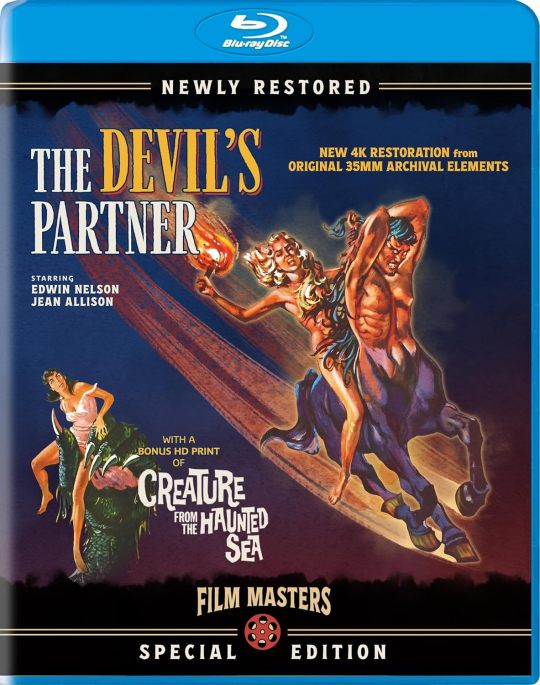
The Devil's Partner and Creature from the Haunted Sea will be released together on Blu-ray and DVD on January 16 via Film Masters.
The Devil's Partner is a 1960 horror film directed by Charles R. Rondeau and written by Stanley Clements and Laura Jean Mathews. Ed Nelson, Edgar Buchanan, Jean Allison, and Richard Crane star.
Creature from the Haunted Sea is a 1961 horror-comedy directed by Roger Corman (The Little Shop of Horrors) and written by Charles B. Griffith (Death Race 2000). Antony Carbone, Betsy Jones-Moreland, and Edward Wain.
The Devil's Partner has been newly restored in 4K from original 35mm archival elements. Creature from the Haunted Sea has been newly scanned in 4K from 35mm archival elements with supplemental 16mm.
Both films are presented in 1.85:1 theatrical and 1.37:1 television aspect ratios. Creature from the Haunted Sea's TV version features 15 minutes of additional footage shot years later to extend the runtime. Special features are listed below.
Special features:
The Devil’s Partner audio commentary by Larry Strothe, James Gonis, Shawn Sheridan and Matt Weinhold of the Monster Party Podcast
Creature From the Haunted Sea audio commentary by film historian Tom Weaver with contributions from Roger Corman, Kinta Zertuche, and Larry Blamire
Interview with Roger Corman
Hollywood Intruders: The Filmgroup Story: Part III featurette
Recut trailers
Creature from the Haunted Sea theatrical trailer
The Devil’s Partner essay by author Mark McGee
Creature from the Haunted Sea essay by film historian Tom Weaver
In The Devil's Partner, an elderly man regains his youth after making a deal with Satan. In Creature from the Haunted Sea, a gangster knocks off his crew members, blaming their deaths on a legendary sea monster.
Pre-order The Devil's Partner and Creature from the Haunted Sea.
#roger corman#the devil's partner#creature from the haunted sea#horror#60s horror#1960s horror#film masters#dvd#gift#ed nelson#antony carbone#60s movies#1960s movies#b movie
9 notes
·
View notes
Text
TheDevilsPartner
#FilmMasters
DVD & Blu Ray
Supernatural Horror Classic, The Devil’s Partner (1961) Newly Restored 4K Special Edition
Includes Newly Restored Bonus Film, Creature From the Haunted Sea (1961)
On Blu-ray & DVD Jan. 16th
Special Features Includes New Interview With Roger Corman
ROCKPORT, Mass. — January 2024 — For Immediate Release — Vintage film restoration and distribution company Film Masters continues its tribute to the pope of pop cinema, Roger Corman, with the third installment of The Filmgroup series on Blu-ray and DVD, The Devil’s Partner, available Jan. 16.
Corman and his brother, Gene, founded The Filmgroup to distribute their own films. While the company did produce the majority of its films, including the cult classic Creature From the Haunted Sea, it also occasionally acquired projects by other filmmakers, as is the case with The Devil's Partner (1961). From director Charles R. Rondeau, the film is a macabre tale of an elderly man who regains his youth after making a deal with the devil. During the summer and fall of 1961, the two films were often paired as a double feature.
Half Man, Half Beast, He Sold his Soul for Passion — Director/actor Edgar Buchanan (best known as Uncle Joe on Petticoat Junction) appears in this supernatural thriller about an old codger trying to reclaim his youth, employing black magic to lure a woman away from his rival. The film also stars Jean Allison, Richard Crane and Ed Nelson. This well-crafted, independent feature has been hailed for its atmosphere and as a pioneering film in the devil worshiping subgenre made popular in the ‘70s.
Made in 1958, The Devil’s Partner languished with no release date until it was picked up and distributed by The Filmgroup, becoming a steady presence on the drive-in circuit, often appearing in tandem with Creature from Haunted Sea, another Corman classic from the golden age of drive-in schlock.
This spoof of spy/gangsters/monster movies stars Anthony Carbone as a gangster and smuggler who decides to kill members of the ship’s bungling crew and blame their deaths on a legendary sea creature. What he doesn’t know is that the creature is actually out there! Also starring Betsy Jones-Moreland and Academy Award-winning screenwriter Robert Towne (Chinatown) under the pseudonym Edward Wain.
The film was conceived when Corman finished shooting The Last Woman on Earth in Puerto Rico and discovered he had enough film left over to make another film. He enlisted long-time associate Charles B. Griffith, who—legend goes—had six days to write the script. Ever the pragmatist when it came to budget, Corman recruited locals to appear in this film as extras.
Special Features: Commentary for The Devil’s Partner is by Larry Strothe, James Gonis, Shawn Sheridan and Matt Weinhold of the Monster Party podcast; theatrical-length commentary for Creature From the Haunted Sea is by fan favorite Tom Weaver, with contributions from Roger Corman, Kinta Zertuche and Larry Blamire. Weaver also provides the liner notes for the film. Ballyhoo Motion Pictures contributes Hollywood Intruders: The Filmgroup Story with Part III of the story, as well as their new interview with Roger Corman on the formation of The Filmgroup; recut trailers, based on the original theatrical trailers; original Creature From the Haunted Sea theatrical trailer (from 16mm archival elements scanned in 4k); and a full essay for The Devil’s Partner by author Mark McGee.
Both films are presented with a theatrical aspect ratio of 1.85:1, as well as in a 1.37:1 television format. The televised version of Creature From the Haunted Sea includes an additional 15 minutes of footage shot years later to extend the film for a sale to Allied Artists. Discs are region free and include English SDH. Audio is DTS-HD/Dolby AC3s.
PRE-ORDER NOW:
https://www.filmmasters.com/devilspartner
About Film Masters:
Film Masters is a consortium of historians and enthusiasts who seek to celebrate the preservation and restoration of films. We are archivists, committed to storing film elements for future generations and reviving films that have been sitting dormant for decades. By scanning in 2K and 4K, we give these lesser-known films the red-carpet treatment they deserve. Leveraging modern means of distribution to release forgotten films back into the world, we also produce original bonus materials, including feature-length documentaries, which aid audiences in contextualizing and celebrating these works of art as they were meant to be. Visit us online at: www.FilmMasters.com
The Devil's Partner (1961) + Creature From The Haunted Sea (1961) Double Feature
Film Masters
Genre: Horror/Sci-Fi/Cult
Original Release: 1961 (B+W)
Not Rated
Format: Blu-ray & DVD
Running Time: 314 Minutes
Suggested Retail Price: $29.95 (Blu-ray) / $19.95 (DVD)
Pre-Order Now
Street Date: Jan. 16, 2024

0 notes
Text
Hollywood’s Changing Depiction of Slavery
I am generally not that comfortable with discussing this kind of thing, especially the attachment it has to cinema, because it is a reminder that many of the people that created the art I love might not be the kind of person I would actually want to meet. In fact, the depiction of slavery in film over the last century can give you an idea of how the American population thought of slaves and the business of slavery in general. I am going to try and approach this objectively, not because I don’t want to offend (if you are offended by my personal abhorrence of slavery in any form than you can go someplace else for your movie commentary), but simply because I am a middle-aged white male who has never encountered slavery in person and everything I know is second hand. I have seen guest lectures that involved people who walked with MLK Jr in Alabama, but I know very little about black oppression and outright slavery in America beyond history books. So, to keep this educational and not slip into personal bias, I will describe what I have seen in some example films over the last century. You are more than welcome to view the films for yourself, however:
SOME SPOILERS FOR THE MOVIES ON THIS LIST!!! I STRONGLY RECOMMEND WATCHING ANY OF THESE FILMS FOR YOURSELF!!
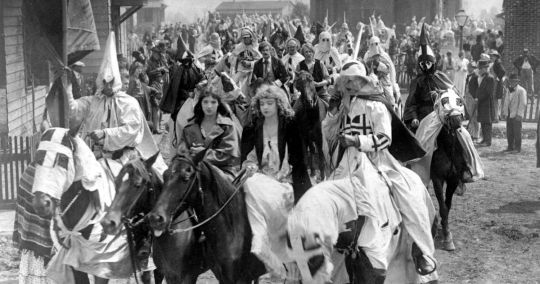
The Birth of a Nation (1915)
We are starting off rough with possibly the most controversial film of all time. There were protests against this film from both black and white cinema goers even at the time (according to the AFI blurb) and it is evident that the director, D.W. Griffith, overstepped some boundaries as he made the apology piece Intolerance the very next year to win back general audiences. The film depicts Abraham Lincoln positively, which was unexpected to me, and former slaves as animalistic and uncontrolled. The Klu Klux Klan comes along and “heroically” controls the former slaves and depicts the reformation as a time in which white women were afraid to walk the street for fear of attack by former slaves. The lack of support for this film by any black actors is apparent since almost all of offensive black men portrayed in the movie are white actors in black face. As difficult as it was for Black Americans to find work outside of farming and industrial labor in the early 1900s, you still couldn’t even pay them to be in this film. It is hard to gauge if many Americans agreed with the opinions reflected in this film at the time, but some people apparently thought that it was a mistake to free the slaves since black people needed to be controlled and why not get free labor for farm owners at the same time.
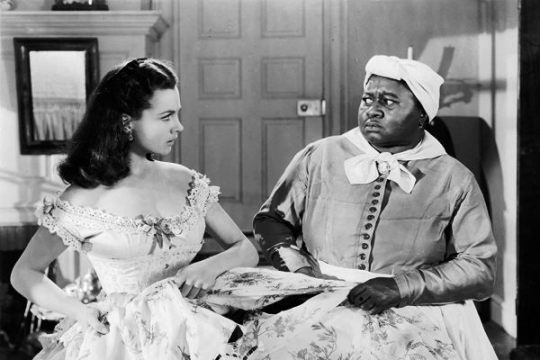
Gone With the Wind (1939)
This is a favorite movie in my family so I cringe slightly watching this film now knowing about about Hattie McDaniel’s Oscar and legacy. The role of Mammy was played by McDaniel and she won the Academy Award for Best Supporting Actress...but she had to get special permission to attend the ceremony since the awards were given out at a segregated hotel. She had to use a back entrance and was seated far in the back in an area that was roped off from the white guests. McDaniel was very good at her role since she had played a maid on over 70 occasions and was hassled by the NAACP to use her award as a platform to promote equal rights. I have little reference to what the world thought of the film, but the 13 Oscar nominations and this being the highest grossing film of all time when adjusting for inflation tells me audiences were OK with if not impressed by the portrayals. It seems that America was accepting of the “friendly and accepting” slave who was like a family friend who wasn’t equal but allowed to stay if they did a good job cleaning up around the house. This was not a very accurate portrayal of most slave-master relationships, which McDaniel admits, but she is quoted as saying “it is better to get $700 a week to play a maid then get $7 a week to be one.”
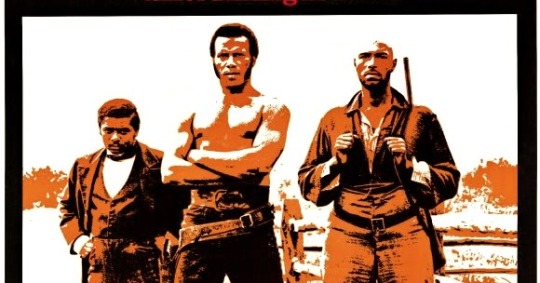
The Legend of N****r Charlie (1972)
During the 60s and 70s, there was a genre of films known as “blaxploitation” which capitalized on the idea that black characters were portrayed stupid thugs that were easily subdued by intelligent white men. This genre did the opposite and featured black heroes who overcame adversity with their power and intelligence, normally over a white adversary. This particular film portrays a slave taken from Africa who is falsely accused of murder and has to run from a racist white sheriff. He turns into a gunslinger and makes a posse of other black gunslingers and this group defeats the evil sheriff and escapes. This portrayal seems as likely as that of Mammy, but the very poor production value and terrible acting (it is pretty difficult to get through) meant no awards. Noting that the box office sales were high almost exclusively at theatres in predominantly black neighborhoods, America was split on the depiction of slaves. White people seemed to be happy with the housemaid while black people wanted a tough hero that rises up and gets vengeance on their oppressors.

Roots (1977): 8 Part Mini-Series
I was unaware that this miniseries was shown over consecutive nights in January of 1977, but tens of millions of people watched all of it (that is 12 hours over 8 nights) and still talk of the impression it made. This movie showed Lavar Burton (you know, the guy from Reading Rainbow and the actor who played the blind guy on Star Trek) as a slave stolen from Africa who was shackled and beaten into a life of submission. This film portrayed slavery as an atrocity that planted seeds of hate and distrust that carried on through generations over hundreds of years. Judging by the ratings, this woke up a lot of Americans to the horror that was slave life. Portraying slaves as happy house maids or whistling old men with big smiles was no longer acceptable. The final episode of this mini-series remains the 3rd highest rated showing of all time according to the Nielson ratings. The series as a whole was nominated for an astounding 32 Emmy Awards and won 9 of them. The low win count was due to multiple actors from the series competing in every acting category. After Vietnam and going into the Cold War, America wanted gritty realism and this seems like exactly that.
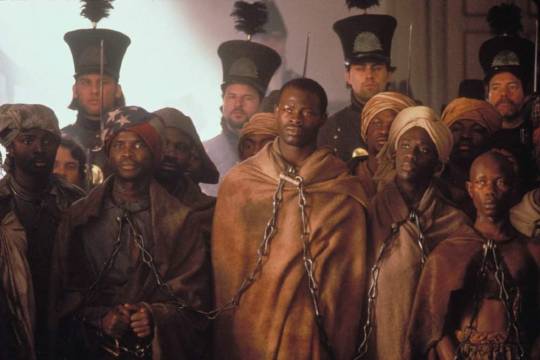
Amistad (1997)
I find this to be idea of slavery that I most relate to as realistic. It stars Djimon Hounsou as a slave that leads a revolt against the slave traders on the ship Amistad in which the entire white crew was slaughtered and the offending slaves were brought to American courts to stand trial for murder. This was based on a true account and directed by Steven Spielberg. One might note that the top billed actors are actually Matthew McConaughey, Morgan Freeman, and Anthony Hopkins, but Hounsou absolutely stole the show. I hate courtroom drama in general, but the testimony of this slave was riveting. According to historian accounts, there was a point during this infamous crossing in which it was decided there was not enough food for all the slaves so a couple of dozen humans were tied to a rock and thrown overboard. It has been over 20 years and that still sticks with me. I wouldn’t expect this to be done to cattle, and the scene of the slaves screaming as they know the rock will pull them down and they have seconds to live still haunts me. It encouraged me to look up accounts of slaves and others who saw first hand how bad things got.
-------------------------------------------------------------------------------------------------------
I took a an anthropology class in the early 2000s and I remember learning about evidence that proved the horrific treatment of some slaves. It is true that some slaves were allowed to live in the house and treated like family. It is true that some slave owners paid their slaves a small amount or even freed them in their will. However, there are also many children of mixed heritage that prove the amount of rape that occurred. There are also bones in shallow graves in back of some of these old plantations that show evidence of multiple breaks, amputations, mangled limbs, and broken backs that have no sign of treatment but the wear and tear of continued use. These people were worked and beaten to death. If that is what happened, then I don’t want it glossed over with Hollywood scriptwriting.
But I said I would be objective so I will stop there. I can feel myself getting angry and opinionated as I write. Learning about history and enjoying a story on film for entertainment can be separate things. Deep breaths.
There are many, many other movies that portray slavery including The Color Purple, Song of the South, Django Unchained, 12 Years a Slave, and Glory. I am not as familiar with these films as the ones listed above, in fact I still haven’t seen 12 Years a Slave. What I wanted to demonstrate was that films will often depict social issues in a way that is consumable by the masses, and changes in the way things are depicted can indicate a change in public opinion. From what I see in film, the American population once thought of former slaves as a problem that needed to be solved and bringing back slavery could solve that issue. It transformed to a feeling that maybe slavery wasn’t all bad and some slave owners were pretty good to their slaves. Black Americans responded with a genre that said that maybe slaves were tough and amazing which scared people into trying to control them. After the Vietnam War and Watergate, Americans wanted the gritty truth and films began portraying slavery as horrific and scarring to the point of affecting generations with hate. Todays movies seem to recognize the atrocities and to almost look at these actions the same way we look at genocides: how could we let this happen? The students that I work with are now assigned movies and readings that highlight genocide and enslavement, which means to me that we are not in denial of how bad it was and instead looking into keeping it from ever happening again. Perhaps there will be a different viewpoint in 20 years. Until then, I will keep watching movies to get an idea of what the public thinks.
#films as history#slavery#slavery in film#Amistad#Roots#Gone with the Wind#the birth of a nation#popular culture#introvert#introverts#american history
23 notes
·
View notes
Text
People are calling for museums to be abolished. Can whitewashed American history be rewritten?
New Post has been published on https://appradab.com/people-are-calling-for-museums-to-be-abolished-can-whitewashed-american-history-be-rewritten/
People are calling for museums to be abolished. Can whitewashed American history be rewritten?

Written by Brian Boucher, Appradab
After years of resisting calls for its removal, New York’s American Museum of Natural History (AMNH) has asked the city to dislodge from its front steps an equestrian monument to Theodore Roosevelt, the twenty-sixth US president, which depicts him charging forward, and towering over two mostly nude figures, one Black and one Indigenous.
In a statement dated June 2020 sent to museum staff, posted on the museum’s website, Ellen Futter, president of the institution’s board, said, “As we strive to advance our institution’s, our City’s, and our country’s passionate quest for racial justice, we believe that removing the statue will be a symbol of progress and of our commitment to build and sustain an inclusive and equitable Museum community and broader society.” (After the announcement President Donald Trump tweeted, “Ridiculous, don’t do it!”)
Might this concession be a harbinger of other changes ahead for American museums? How can institutions whose leadership is often overwhelmingly White rethink their staffing, collections and exhibitions, much less move toward more truly equitable governance? Or, some ask, should museums continue to exist in anything like their current form?


The controversial statue of former President Theodore Roosevelt outside of the Museum of Natural History, featuring a Black man and a Indigenous man at his sides Credit: Spencer Platt/Getty Images North America/Getty Images
The Natural History Museum’s statement places the monument’s removal in the context of “the ever-widening movement for racial justice that has emerged after the killing of George Floyd,” a Black man who was killed by four police officers in Minneapolis, Minnesota, one of whom knelt on his neck for nearly nine minutes. After a video of Floyd’s killing went viral, tens of thousands took to the streets in protest in the US and around the world, even in the midst of a pandemic, to demand accountability for police brutality and to call for the defunding, or even the abolition of local police forces, among other demands.
The presence of an Indigenous figure in the Roosevelt monument, and the museum itself, have a very personal meaning for Wendy Red Star, an artist and member of the Crow tribe. She created a project, “The 1880 Crow Peace Delegation,” about a group of Crow chiefs who traveled to Washington, DC, that year to try to negotiate a peace treaty. In researching for the project, she found that the remains of one of those chiefs, Pretty Eagle, had been stolen from a burial site and later sold to the AMNH. The tribe was able to repatriate the remains in the 1990s.
“It wasn’t until I did this project that I learned about that,” Red Star said in a phone interview. “The Roosevelt monument was the first thing I thought of. To me, it’s a really direct connection to how my people have been presented at the museum — along with the dinosaur bones as part of the natural world. It’s always been such a surreal experience to see my community’s objects on display and watch people observing them as if these were peoples of the past.”
Just as government, law enforcement, and all forms of authority are being questioned in this moment of upheaval, museums worldwide have come in for intense scrutiny, and the situation on the ground is changing very fast. Earlier this month, dozens of current and former staffers of multiple cultural institutions, including the Metropolitan Museum, the Guggenheim Museum, and the Museum of Modern Art as well as institutions nationwide, published an open letter accusing the institutions of unfair treatment of employees of color and saying that “your covert and overt white supremacy that has benefited the institution, through the unrecognized dedication and hard labor of Black/Brown employees, with the expectation that we remain complacent with the status quo, is over.”


Apsáalooke Feminist #4, 2016, by Wendy Red Star Credit: Courtesy Wendy Red Star
Within days, staffers at the Guggenheim and the San Francisco Museum of Modern Art openly accused the institutions’ leadership of racism. In an emailed statement to Appradab, Richard Armstrong, director of the Solomon R. Guggenheim Museum and Foundation, said the institution was prepared to address these concerns:
“As a society, we are confronting sustained injustices never resolved, and feel today the pain and anger of previous moments of turmoil. The Guggenheim addresses the shared need of great reform, and long overdue equality, and want to reaffirm that we are dedicated to doing our part.
“In this period of self-reflection and reckoning, we will engage in dialogue with our staff and review all processes and procedures to lead to positive change,” he continued. “We are expediting our ongoing … efforts to produce an action plan for demonstrable progress.”
The Metropolitan Museum declined to comment. The Museum of Modern Art and the San Francisco Museum of Modern Art did not respond to requests for comment.
Museums have also been critiqued for issuing anodyne statements that failed to mention Floyd or the Black Lives Matter movement. The Getty Museum, in Los Angeles, posted an unspecific call for “equity and fairness” on Instagram, and later apologized; the director of New York’s Metropolitan Museum of Art privately apologized to Black artist Glenn Ligon for using a work of his from the museum’s holdings on social media without his permission, according to the New York Times.


Decolonize This Place protesting outside the American Museum of Natural History Credit: Andres Rodriguez/Decolonize This Place
The AMNH’s statement does not mention the groups that have for several years organized protests calling for the Roosevelt monument’s removal. In a phone interview, Decolonize This Place (DTP) organizer Amin Husain pointed out that removal of the monument was just one of three demands that Decolonize had placed on the museum, which include internally renaming Columbus Day as Indigenous People’s Day and rethinking the museum’s displays.
“Many of the museum’s galleries contain Indigenous remains and objects,” he said. “Those things need to be sent back to the people they were taken from, and the exhibitions must be completely overhauled in consultation with, and with the active participation of, the relevant stakeholders.”
While many U.S. museums have made moves toward what the field calls “diversity, equity, and inclusion,” fellow DTP organizer Marz Saffore called for much greater change. “It’s critical that we move past identity politics,” she said. “It’s not enough to hire an Indigenous curator. It’s not enough to have one Black person on your board. Museums as we know them have to be abolished. I don’t want my voice to be added to museums that are often trophy cases for Imperialism.”
Institutions like the AMNH will continue to be sites for debate, some of which may echo heated arguments among historians and activists on how to handle monuments to objectionable historical figures. This includes leaders of the Confederate Army in the US Civilw War, which were erected by Confederate sympathizers oftentimes decades after the war, with a conscious white supremacist purpose.
Some ask whether these monuments could, rather than being destroyed or removed, be altered by, for example, adding contextualizing information. In an interview with National Public Radio on Tuesday about the Roosevelt monument, historian Manisha Sinha suggested that this tribute to Roosevelt’s efforts toward nature conservation could still stand, if the subjugated Black and Indigenous figures were simply removed. (DTP pointed out in an emailed statement that the land Roosevelt “conserved” was stolen from Indigenous people, so they would hardly find that an acceptable solution.)
By contrast, Abraham Lincoln scholar Harold Holzer, former public affairs czar for the Metropolitan Museum of Art in New York and author of books including “Lincoln and the Power of the Press: The War for Public Opinion” (2014), wrote an editorial this month for the New York Daily News saying that while he had earlier asked whether Confederate monuments could be altered, he’d concluded that they must be removed. “I was not only wrong,” he wrote; “I was insensitive.”


Michael Diaz-Griffith, executive director of the Sir John Soane’s Museum Foundation, has written a pamphlet on how to be an anti-racist preservationist Credit: Michael Diaz Griffith
Michael Diaz-Griffith, executive director of the New York-based Sir John Soane’s Museum Foundation, which supports the Soane Museum in London, is author of “The Anti-Racist Preservationist’s Guide to Confederate Monuments: Their Past and a Future Without Them,” a pamphlet that succinctly explains how such monuments have a foundation in white supremacy, and outlines why they should be struck from the public realm. “In the case of the Confederates there’s no public legacy to detach from their wrongdoing,” Diaz-Griffith said over the phone.”The Confederacy was an immoral enterprise.”
Diaz-Griffith envisions a future, sooner or later, free of tributes to any such contentious figures.
“I think that all named buildings, all named places, will end up being reevaluated,” he said. “Who should they be named after? Do we continue to focus on those who were recognized in their own times, or do we shift our attention to those who fought for justice but weren’t publicly honored when they were alive? Since all people are fallible, it may be a good idea to erect monuments to principles, like justice, rather than to individuals.”
US museums, dependent as they are on the largesse of wealthy individuals and families, are far from a future in which controversial donors, who, for instance, hold views that run counter to science, nonetheless have galleries or other features named for them. The AMNH itself was under scrutiny for taking money from Rebekah Mercer, a major donor to the Republican party, whose leader Donald Trump has repeatedly denied the existence of climate change during his time in office. Mercer left the board when her term ended in 2019. Meanwhile in 2014, the Metropolitan Museum of Art named the revamped plaza on Fifth Avenue for donor David H. Koch, likewise a Republican donor, who is notable for funding efforts to undercut climate change science.
But the activists who had called for the removal of the Roosevelt monument have more foundational questions in mind than who funds such cultural organizations. Representing the group NYC Stands with Standing Rock, Sandy Grande, using the Lenape people’s name for Manhattan, said in a phone interview, “We should underscore that the city (Mannahatta) wouldn’t exist without the land and labor of Black and Indigenous peoples. This is Lenape land and the Mohawk and Seneca peoples built much of the city. In addition to Black people’s labor, their settlement at Seneca Village was destroyed.”
“So,” she said, “the removal of the monument has been a long time coming, not just for the museum but for the city itself, and we will continue to press for change.”


Makeba Clay, the Phillips Collection’s first chief diversity officer Credit: Rhiannon Newman/Courtesy Makeba Clay
“This is an historic moment — a pause and reflect moment for individuals and institutions,” said Makeba Clay, the chief diversity officer at the Phillips Collection in Washington, DC, over email. “The systemic and unrelenting injustices against members of the Black community have existed for hundreds of years and continue to exist all around us, including in our museums. We know we have work to do and that means being actively anti-racist — not passively non-racist.”
Clay was the inaugural appointee to her role, which she took on in 2018 and her message is that it’s not enough to “amplify” voices and messages, art institutions must take action. “We are looking at our staff and board, both overwhelmingly white, and actively examining our hiring and recruitment processes to promote greater diversity,” she said. “We recently held a town hall, which uncovered stark differences between staff of color and white staff.”
Clay also said that art does not exist outside struggle. That while it can be used for “constructive discourse, building empathy and creating community,” art also “can confront current issues and topics that aren’t neutral.”
Adding: “What appears like radical action is exactly what museums need to pursue to prove that they have a valuable role to play in this national discourse.”
Top image: Fall, from the series Four Seasons, 2006, by Wendy Red Star.
0 notes
Text
The Canonical Gospels
Explore the New Testament and its authors in the BAS Library
Matthew, Mark, Luke and John—the four canonical Gospels—have come down to us in Greek. From old Greek manuscripts, the Gospels we use today have been translated countless times, into countless languages. These translations all differ from one another, allowing for multiple versions of the same writings. With so many variations of each text, is any one version of a Gospel more accurate than the next?
In contrast, the Hebrew Bible was written in Hebrew, with a few short sections in a sister language called Aramaic. Were the canonical Gospels really originally written in Greek? In “Was the Gospel of Matthew Originally Written in Hebrew?” Biblical scholar George Howard presents formidable evidence from a little-known 14th-century manuscript that at least one of the Gospels, and perhaps more, may originally have been written in Hebrew!
“To Be Continued … The Many Endings of the Gospel of Mark” by Michael W. Holmes explores the nine versions of the last chapter of the Gospel of Mark that we have today. The shortest version ends with the empty tomb; Jesus is never seen again. In the longest, Jesus reappears three times before he rises to heaven.
The difference is critical—to Bible scholars trying to determine which ending is the earliest, to biographers mapping the course of Jesus’ life, to historians trying to trace how it came to be recorded, to theologians contemplating Jesus’ resurrection, and to curious readers who simply want to know how the story ends.
Who Really Wrote Luke?
In “Who Wrote the Gospel of Luke?” Mikeal Parsons investigates a seemingly obvious question: Who is Luke? The gospel itself never reveals the author’s name.
Over the centuries, numerous traditions have evolved around this somewhat shadowy evangelist: Luke is credited with writing not only his gospel but the New Testament Book of Acts as well. He is portrayed as a physician, a friend of Paul’s and even a painter, and is described as a gentile writing for a gentile audience. Parsons examines the author of two of the most significant contributions to our understanding of the founders of Christianity and its first followers.
John and Jesus
Commentators have long debated whether John provides the truest portrait of Jesus or the least accurate. But perhaps they should be asking another question altogether: What kind of book is the so-called Gospel of John?
The brisk dialogue and memorable sayings of the Synoptics give way to a handful of elaborate set pieces in John. In “The Un-Gospel of John,” Robin Griffith-Jones considers this more spiritual gospel. While the other gospels tell Jesus’ stories from the outside, John reveals the heart of Jesus.
You can discover the details of the language used, the authors of the gospels, and even learn about the nature of Jesus—as well as much more—by diving into the Biblical Archaeology Society’s renowned library, including the Special Collection The Canonical Gospels.
Read all of these eye-opening articles and more from the pages of Biblical Archaeology Review and Bible Review:
"Was the Gospel of Matthew Originally Written in Hebrew?"
By George Howard
"To Be Continued..."
By Michael W. Holmes
“Who Wrote the Gospel of Luke?”
By Mikeal Parsons
“The Un-Gospel of John”
By Robin Griffith-Jones
http://reply.biblicalarchaeology.org/t?r=2686&c=4112560&l=209532&ctl=4F70C58:C786FD5649800C2907AC4F9D4BF9934CAA39341E05584C23&
As a subscriber to the Biblical Archaeology Society Library, you are able to enjoy this remarkable collection of scholarly articles. And that’s worth quite a lot to students of the Bible and archaeology like you, because this collection, The Canonical Gospels, is just a tiny sample of what you get in the BAS Library with an All-Access pass.
0 notes
Text
Starting May 29, Tamaqua area residents will notice something different around town. Twelve large fiberglass hearts will be placed throughout the borough as part of the ‘Tamaqua Has Heart’ project. The size of each piece will be 39-inches tall, 42-inches wide, 20-inches deep.
A special reception was held yesterday to give sponsors a chance to choose what artwork they wanted via pre-drafted drawings from various local artists. It also provided a chance for the sponsors to meet all the artists.
Over the next few months, these artists will work to place their sponsor-selected, one-of-a-kind artwork on these hearts.
Submitted. From left are project leaders Kyle Whitley, Wandie Zammer-Little, Leona Rega, and Lacey Timony.
The hearts will be displayed on temporary mounts at various locations throughout the borough from Memorial Day to Labor Day (September 4, 2017).
One heart’s location, called “The Heart of the Community”, will be permanent.
Clear protectant will be placed on each artwork to shield each from the elements.
In the fall, a special arts gala will be held at the Tamaqua Community Arts Center to auction the artworks off to art lovers, historians and collectors.
Spearheading the project were volunteers Kyle Whitley and Wandie Zammer-Little, with administrative support by Leona Rega and Lacey Timony of the Tamaqua Community Arts Center.
The project’s mission statements reads, “There are multiple goals behind Tamaqua Has Heart. One being uniting the community through the arts by calling on artists and local businesses to collaborate on a sculpture installation that will encompass locations throughout downtown Tamaqua. By drawing attention to our downtown, we hope to promote tourism and our local history.”
(Page down futher to view video and all photos from the reception event. Or HERE to view on Facebook.)
Sponsors are:
Barbershop Singers of Mahanoy City
Cyan Sky Copier Technologies
Dr. Joanne Calabrese
Flossie Fegley & Family in memory of William H. Fegley
James R. Gelatko
Jay Hollenbach Plumbing & Heating
Lech Transportation
Lehigh Carbon Community College
Mauch Chunk Trust Company – Tamaqua/Hometown
Robert J. Gelatko
Sankie Griffith – E. Franklin Griffiths Funeral Home and Cremation Services, Inc.
Shafer’s Pharmacy
St. Luke’s University Health Systems
Tamaqua Area High School Class of 1978
Tamaqua Area High School Class of 1992
Tamaqua Station Restaurant
Times News, LLC
Artists are:
High School Media Class
Joseph Evanousky
John McCoy
Kevin Smith
Kim East
Kimberly Woodward
Lori Remmel
Paul Corinchock
Susan Sidoriak
Suzanne Dalton
Tamaqua High School Photo 1 Students
Click HERE for more information via their webpage. Or HERE for press release.
Meet The Artist posters:
Submitted artist drawings:
All other photos:
12 ‘Tamaqua Has Heart’ art pieces to be displayed throughout Tamaqua Starting May 29, Tamaqua area residents will notice something different around town. Twelve large fiberglass hearts will be placed throughout the borough as part of the 'Tamaqua Has Heart' project.
0 notes
Note
hi there! i was wondering, what would your book recs be on the topic of margaret of anjou and henry vi? preferably nonfiction. thank you!
Hi! I'm sorry for taking so long to reply, here goes my answer:
For Margaret of Anjou I would recommend:
Helen Maurer's biography Margaret of Anjou: Queenship and Power in Late Medieval England
The Letters of Margaret of Anjou, a collection by Helen Maurer and B. M. Cron.
Joanna Laynesmith's The Last Medieval Queens: English Queenship 1445-1503, a study on Margaret and her three royal successors (focusing on the exercise of queenship)
There are also some pop history books like Amy Licence's Red Roses: Blanche of Gaunt to Margaret Beaufort, and Sarah Gristwood's Blood Sisters: The Women Behind the Wars of the Roses but I wouldn't particularly recommend them. I understand they may be more accessible, though!
For Henry VI, I would recommend:
R. A. Griffiths' The Reign of Henry VI, a classic (and giant) work
James Ross' Henry VI: A Good, Simple and Innocent Man (Penguin Monarchs series), a more accessible biography recommended to me by @nuingiliath ♡
Katherine Lewis' Kingship and Masculinity in Late Medieval England, a study on the exercise of medieval kingship and masculinity focusing on the lives of Henry V and Henry VI
Lewis has also written about Henry VI in Holiness and Masculinity in the Middle Ages and Religious Men and Masculine Identity in the Middle Ages. I don't know much about pop history books when it comes to Henry VI but I was warned against Lauren Johnson's The Shadow King. I can't personally vouch for it either way, though!
I hope this answer was helpful! 🌹x
#again sorry for taking so long#ask#anon#margaret of anjou#henry vi#book recs#historian: helen maurer#historian: b. m. cron#historian: j. l. laynesmith#historian: r. a. griffiths#historian: james ross#historian: katherine j. lewis
49 notes
·
View notes
Quote
[The Battle of Bosworth] was the first battle fought in England since 1066 in which the anointed king - who was widely acknowledged as king and on whom therefore, according to popular conviction and regnal theory, God had smiled - had been defeated and slain, even though he had worn his crown to battle and had stood beneath his unfurled banner. Not since Harold Godwinson died at Hastings had the God of battles changed his mind so devastatingly, even though in August 1485 Richard III had been on the throne of England three times as long as had Harold in October 1066.
R. A. Griffiths, Henry Tudor: The Training of a King
#henry vii#r*chard iii#battle of bosworth field#historian: r. a. griffiths#henry tudor: the training of a king#happy bosworth day folks 🌹
92 notes
·
View notes
Text
Blu-ray Review: A Bucket of Blood
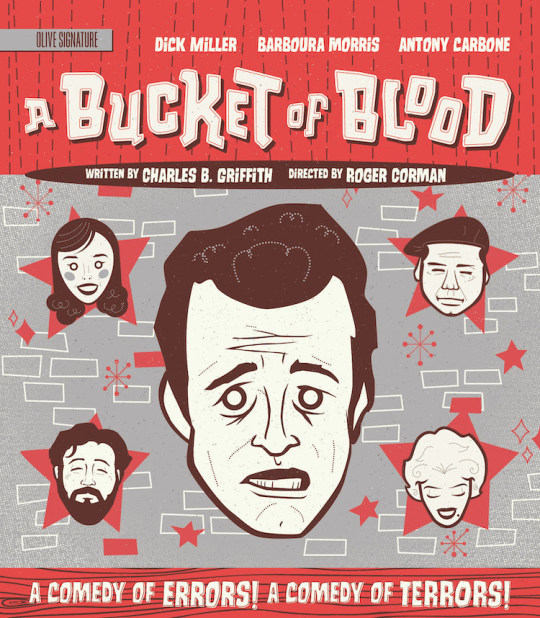
Dick Miller was such a constant presence in cinema that his death earlier this year was almost like losing an old friend. His familiar face would often only pop up for a scene or two, but he would almost always steal them. Thankfully, he had a long life and left behind plenty of movies through which he lives on. Over the course of his six-decade career, Miller amassed over 150 acting credits, including Gremlins, The Terminator, Twilight Zone: The Movie, The Dirty Dozen, The 'Burbs, 1941, and Tales from the Crypt: Demon Knight.
1959's A Bucket of Blood is significant for several reasons, perhaps the most notable one being that it's a rare leading role for the character actor. Miller stars as Walter Paisley, a name that would follow him throughout his career, as later filmmakers would adopt it for Miller’s cameo appearances. A Bucket of Blood is also one of Roger Corman's best directorial efforts. It may not have the cache of his Edgar Allan Poe adaptations with Vincent Price or the cult status of The Little Shop of Horrors, but it's one of his most entertaining works.
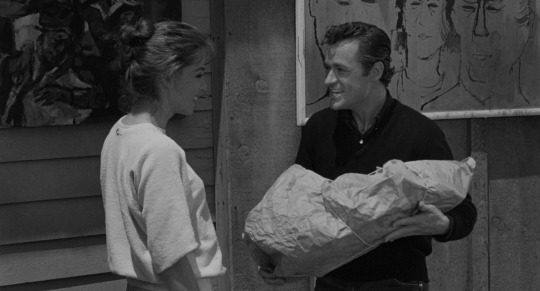
In typical Corman fashion, A Bucket of Blood was conceived as a way to repurpose leftover sets from 1959's Diary of a High School Bride. He hired writer Charles B. Griffith - their first of three horror-comedy collaborations, succeeded by The Little Shop of Horrors (which not only follows the same plot structure but also reused the sets) and Creature from the Haunted Sea - to pen the script in five days. Corman then shot the film in another five days on a budget of $50,000. Running an economical 66 minutes, it remarkably doesn't look nearly as cheap or as rushed as it undoubtedly was.
Miller's Walter Paisley is a cafe busboy who dotes on insufferably pretentious artists but has ambitions of being one himself. After accidentally killing a cat, inspiration strikes to cover it up as a grotesque yet dignified sculpture. When the local art critics and collectors respond positively to it, he's pressured to replicate the success. The taste of fame goes to his head, turning Walter into one of the obnoxious beatniks who once mocked him, amidst his inadvertent murder spree.
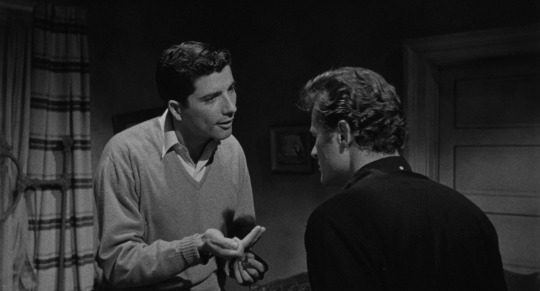
Miller cited A Bucket of Blood as his favorite role, and it is indeed a highlight of his storied career. Giving new meaning to the phrase "tortured artist," the pathos he brings to the character allows him to walk the line between protagonist and antagonist. Miller even subtly shifts his body language from a meek hunch to a poised swagger as his newfound notoriety boosts his confidence. Along with a bevy of Corman's B-movie regulars, the cast notably features Ed Nelson (Peyton Place) and future game show host Bert Convy (Win, Lose or Draw).
Corman’s filmmaking prowess lies not only in his penchant for pinching pennies, but also his talent for discovering and surrounding himself with talent. Despite the restricted time frame, director of photography Jacques R. Marquette (Burnt Offerings, Attack of the 50 Foot Woman) was able to deliver quality images. Shot in black and white, the use of shadows and lighting is inspired. Selections from the film's jazz score, composed by Fred Katz, were reused in The Little Shop of Horrors and Creature from the Haunted Sea.
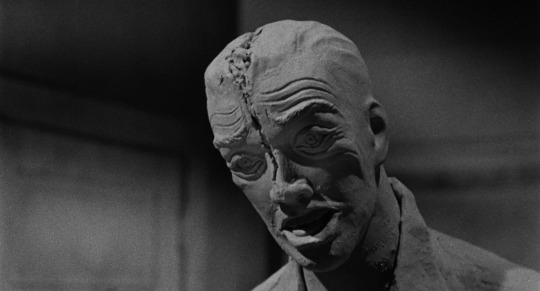
A Bucket of Blood has been released on Blu-ray as part of Olive Films' Olive Signature line. Limited to 3,500 units, this edition is housed in a slipcase along with a booklet featuring an essay on the film and its legacy by Caelum Vatnsdal, author of You Don’t Know Me, But You Love Me: The Lives of Dick Miller. The film itself has been mastered from a new 4K scan, looking as pristine as ever in honor of its 60th anniversary, and is accompanied by a variety of special features.
In an interview shot mere months before his passing, Miller is joined by his wife, Lainie Miller, for a 12-minute interview. His declining health is apparent, but he remains charming, particularly in his interactions with Lainie. Corman, as efficient and sharp as ever at the age of 93, tells the story of the making of the movie in under eight minutes. An archival audio interview finds Griffith briefly discusses each of his scripts over the course of 20 minutes. The 8mm "digest" version of the picture, which could be enjoyed at home before VHS was invented, is included; condensed to an 8-minute, silent montage of murders followed by the final chase.
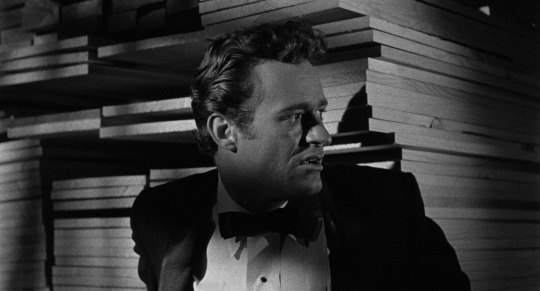
Elijah Drenner, director of the fantastic documentary That Guy Dick Miller, provides an audio commentary, which he begins by calling A Bucket of Blood "Corman's first great movie." It largely plays like a film historian track, detailing the production and its players, but his relationship with Miller makes it more engaging. Drenner also provides a brief visual essay comparing the original, 93-page script (titled The Yellow Door) to the final product, recreating unfilmed passages like an audio drama.
One of the most fascinating special features is the prologue from the film's German release, where - in a clever but misleading advertising strategy that would make Corman proud - it was marketed as a sequel to House of Wax. The 10 minutes of German footage purports that Walter Paisley is the last descendant of Vincent Price's character (portrayed by an unknown German actor under prosthetics). Extras are rounded out by a digital version of Vatnsdal's booklet essay, a gallery of recently discovered on-set photography, and the U.S. and German theatrical trailers.
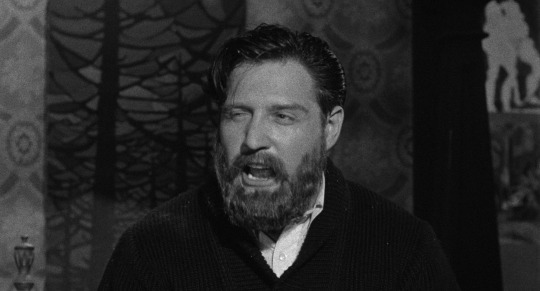
Nary a dull moment among its lightning-fast pacing, A Bucket of Blood works remarkably well 60 years later. The concept remains timely, as both the social commentary and dark satirization of the counterculture art scene still play. It was already remade once as a TV movie starring Anthony Michael Hall in 1995, but you could swap out beatniks for today’s hipsters to make a contemporary, subversive slasher-comedy of errors in the vein of Tucker and Dale vs Evil.
A Bucket of Blood is available now on Blu-ray via Olive Films.
#a bucket of blood#roger corman#dick miller#charles b. griffith#bucket of blood#ed nelson#bert convy#olive films#dvd#gift#review#article#little shop of horrors#50s horror#1950s horror#b movie
12 notes
·
View notes
Quote
[Henry VII]’s efforts were unremitting, persuasive, and extraordinarily successful. Within a century of Bosworth, Henry was viewed as the reincarnation of biblical heroes: as Moses, a second Solomon, and as the new King David who had liberated the Welsh just as the Jews had been freed from Babylon. By others he came to be regarded as preparing the way for the union of three kingdoms under his great grandson, James VI and I […] An Italian visitor in 1498 could conclude, after talking about the Welsh and their relations with the English over the centuries: “They may now, however, be said to have recovered their former independence, for the most wise and fortunate Henry the 7th is a Welshman.”
R. A. Griffiths, Henry Tudor: The Training of a King
26 notes
·
View notes